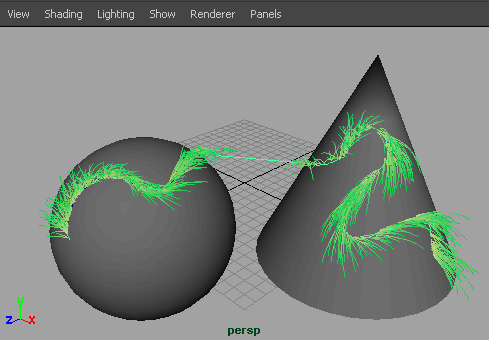To paint on NURBS or polygonal objects, you must first make the objects paintable. When you paint directly on a paintable
object, creates a curve on the surface along the stroke path and attaches the stroke and new brush to it. When you translate the
object, the stroke moves with it. You can offset the brush from the surface.
As you paint, the stroke does not leave the surface unless you paint over another object that is paintable. If you do paint
across another paintable object during the stroke, the stroke will continue on the other object, bridging the two objects.
Note
You can only paint on NURBS or polygonal objects.
Note
- Because the stroke attempts to stay on the surface, the result may be unexpected. For example, suppose you have a sphere intersecting
a plane. If you start painting on the sphere, once the brush leaves the sphere, it looks for another surface to continue on,
the plane in this case. However, if you start to paint on the plane, the brush never leaves the surface, so the stroke doesn’t
continue on the sphere.
- When you paint across the joined edges of a surface (for example, the center line on a face created by duplicating half the
face and attaching it to the first half), your brush stroke may appear to “leak” through the join. To remedy this, make the
surface periodic in U and V.
- Duplicating objects with strokes does not duplicate the strokes.
To paint on objects
- Select the NURBS or polygonal object(s) you want to paint on. If you are in the scene painting view, Ctrl-click (Windows and
Linux) or Control-click (Mac OS X) on an object to select it.
- Select Paint Effects > Make Paintable.
Note
- When you select , only the currently selected objects are paintable. Any objects previously made paintable become unpaintable.
- When you save and retrieve the scene, any paintable objects become unpaintable. To paint on these objects, you must make them
paintable again after retrieving.
- Select Paint Effects > Paint on Paintable Objects.
Note
If there are no paintable objects in the scene, your strokes will lie on the grid plane of the perspective view.
- In the (Paint Effects > Get Brush), or on a shelf, click the brush preset you want to paint with.
- Modify stroke settings, if necessary (Paint Effects > Paint Effects Tool >
 ). For information on modifying stroke settings, see Define default stroke settings.
). For information on modifying stroke settings, see Define default stroke settings.
- Modify brush attributes, if necessary (Paint Effects > Template Brush Settings). For information on modifying brush attributes, see Define template brush settings.
Tip
- You can use hotkeys on the canvas to interactively change the (set ModifyUpperRadius, default hotkey, b), the only (set ModifyLowerRadius), and (set ModifyDisplacement, default hotkey, m) under in the . For information on other hotkeys, see Use default Paint Effects hotkeys.
- You can set a hotkey to reverse the surface normal when you paint strokes on mirrored surfaces. For details, see Reverse surface normals on painted objects.
- In either the scene view or the scene painting view, drag across the plane.
For information on the scene painting view, see Render strokes as you paint. For information on working in the scene painting view, see Automatically paint multiple strokes on a surface.
Tip
To paint on the grid plane of the perspective view after painting on objects, in the scene view, deselect all objects by clicking
anywhere on the scene that is not an object, then select Paint Effects > Make Paintable.
 Except where otherwise noted, this work is licensed under a Creative Commons Attribution-NonCommercial-ShareAlike 3.0 Unported License
Except where otherwise noted, this work is licensed under a Creative Commons Attribution-NonCommercial-ShareAlike 3.0 Unported License



 ). For information on modifying stroke settings, see Define default stroke settings.
). For information on modifying stroke settings, see Define default stroke settings.
 Except where otherwise noted, this work is licensed under a Creative Commons Attribution-NonCommercial-ShareAlike 3.0 Unported License
Except where otherwise noted, this work is licensed under a Creative Commons Attribution-NonCommercial-ShareAlike 3.0 Unported License